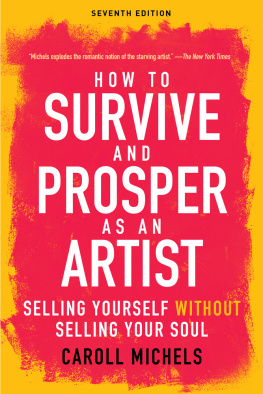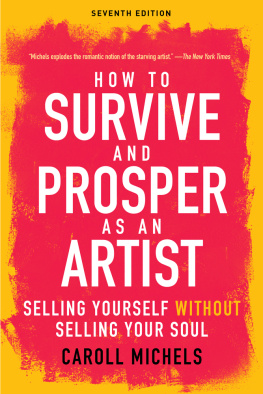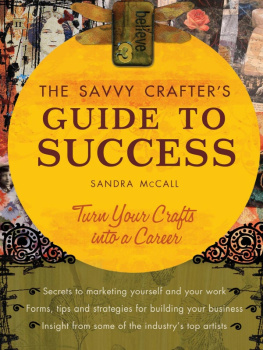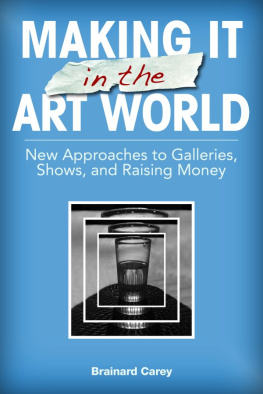Copyright 2018 by Caroll Michels
All rights reserved. Copyright under Berne Copyright Convention, Universal Copyright Convention, and Pan American Copyright Convention. No part of this book may be reproduced, stored in a retrieval system, or transmitted in any form, or by any means, electronic, mechanical, photocopying, recording or otherwise, without the express written consent of the publisher, except in the case of brief excerpts in critical reviews or articles. All inquiries should be addressed to Allworth Press, 307 West 36th Street, 11th Floor, New York, NY 10018.
Allworth Press books may be purchased in bulk at special discounts for sales promotion, corporate gifts, fund-raising, or educational purposes. Special editions can also be created to specifications. For details, contact the Special Sales Department, Allworth Press, 307 West 36th Street, 11th Floor, New York, NY 10018 or .
22 21 20 19 18 5 4 3 2 1
Published by Allworth Press, an imprint of Skyhorse Publishing, Inc., 307 West 36th Street, 11th Floor, New York, NY 10018. Allworth Press is a registered trademark of Skyhorse Publishing, Inc., a Delaware corporation.
www.allworth.com
Cover design by Mary Ann Smith
Library of Congress Cataloging-in-Publication Data
Names: Michels, Caroll, author.
Title: How to survive and prosper as an artist: selling yourself without selling your soul / Caroll Michels.
Description: Seventh edition. | New York: Allworth Press, 2018. | Includes bibliographical references and index.
Identifiers: LCCN 2017051395 (print) | LCCN 2017051788 (ebook) | ISBN 9781621536185 (e-book) | ISBN 9781621536130 (pbk.: alk. paper)
Subjects: LCSH: ArtVocational guidanceUnited States. | ArtMarketing.
Classification: LCC N8350 (ebook) | LCC N8350 .M46 2018 (print) | DDC 702.3dc23
LC record available at https://lccn.loc.gov/2017051395
Print ISBN: 978-1-62153-613-0
eBook ISBN: 978-1-62153-618-5
Printed in the United States of America
WITH GRATITUDE
To Monika Verma of Levine Greenberg Rostan Literary Agency for all her support and assistance, and to Tad Crawford, founder and publisher of Allworth Press, where the new edition of my book found its real home.
Contents
CHAPTER 1
Career Development for Artists :
Then and Now
In the late 1970s, I began counseling visual and performing artists and writers on career management and development, an occupation that I am credited for inventing. Originally, I called myself an artists consultant. In 1990, I changed my title to career coach and artist-advocate, a description that succinctly describes the work that I do.
Prior to inventing a new occupation, I worked in a collaborative of artists and architects, Haus-Rucker-Co, that was founded in Vienna, Austria. Three members of our group, including me, moved to New York, where we formed a nonprofit organization, Haus-Rucker-Inc. We were primarily involved with public art projects and also performed a study on ways to utilize urban rooftop space for cultural, recreational, and commercial facilities. The study was funded by the National Endowment for the Arts in conjunction with The Cooper Union for the Advancement of Science and Art. Before Haus-Rucker-Inc. disbanded, we had a solo show at Centre Georges Pompidou in Paris; Archologie de la Ville was one of the museums inaugural exhibitions. Our work has continued to be recognized well into the 21st century, with a retrospective exhibition in 201415 at Haus am Waldsee, Institut fr Internationale Kunst in Berlin.
This book contains information and advice derived from all my experiences when I was working as an artist, as well as those of my clients, and most certainly some subliminal messages that I received from my childhood and adolescent years. I have offered perceptions, observations, and advice that would have been invaluable to me when I first started working as a visual artist.
Although I am no longer doing artwork (I am an obsessive dance student), I have always been proud that I was able to live off my earnings as an artist. I established a track record for winning grants and corporate sponsorships. I developed my own public relations campaigns and was regularly published in newspapers and periodicals.
Managing my own career was something that no one person taught me. I learned from several individuals, positive and negative encounters, trial-and-error experiences, and intuition.
Measuring my success as an artists career coach is very similar to measuring my success as an artist. In both professions I have achieved immediate success, long-range success, and no success. I have received direct feedback, indirect feedback, and no feedback. I have felt successful in my work when my clients have followed up and used my advice, leads, and information that led to invitations to exhibit and perform; were awarded commissions, grants, and fellowships; received press coverage; and were successful in their negotiations with art dealers.
Although many of the examples and anecdotes I use to illustrate or make a point involve visual artists, performing artists and writers will also be able to identify with many of the situations.
This book does not provide all the answers an artist is seeking, nor does it contain everything an artist needs to know about the art world. However, it fills in the gaps that have been omitted, overlooked, or ignored in other publications; it elaborates on subjects that have been inadequately covered and challenges some basic notions about what an artists career is all about. It contains advice, opinions, and impressions that will not be particularly palatable to members of the art worldincluding artists, the media, funding agencies, art collectors, art dealers, arts administrators, curators, and criticsbecause it also explores the ills and injustices of the art world and sheds some light on who is responsible.
When the first edition of this book was published in 1983, there was only one other book on the market that offered career advice to artists. It was titled The Artists Guide to His Market, and it was published in 1970. Although in subsequent editions the sexist title was changed to The Artists Guide to the Art Market , in all the editions the author consistently advised that it would be unrealistic for artists to believe that they can earn a living through art sales.
Many more books on career management are now on the market. Some of the books express sentiments that are optimistic and empowering. Other books continue to put art dealers in the drivers seat and believe that dealers know best. Some books were written by people with little or no experience in the art world and approach art marketing in the same way one would go about marketing a new restaurant or selling underwear online!
This book addresses artists roles in advancing and bettering their lot and taking control of their careers. What artists need most is objective advice, but what they usually receive is reinforcement of a myth of what it is like to be an artist. All too often artists are characterized as underdogs, and accordingly this image is strengthened throughout their careers. I cant promise that all of my advice is objective, since my own personal experiences come into play, but the original incentive to write this book came about when I realized how much underdog philosophy was being published under the guise of nuts and bolts career management.
You will rarely find the word talent used in the forthcoming pages. The belief that an artist has talent is a subjective judgment, and there is no guarantee that a talented artist will be successful or that a successful artist is talented.












